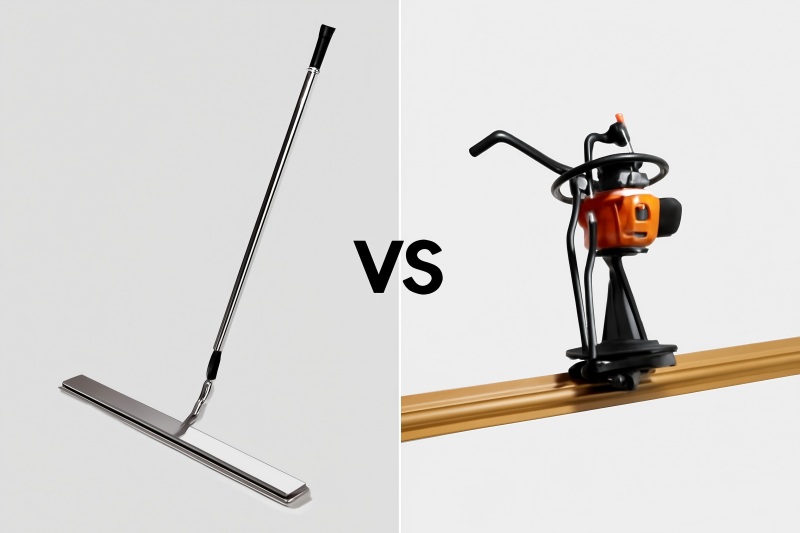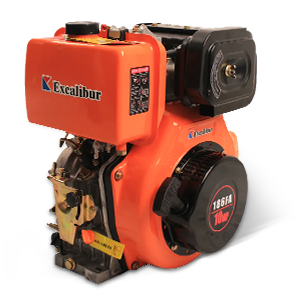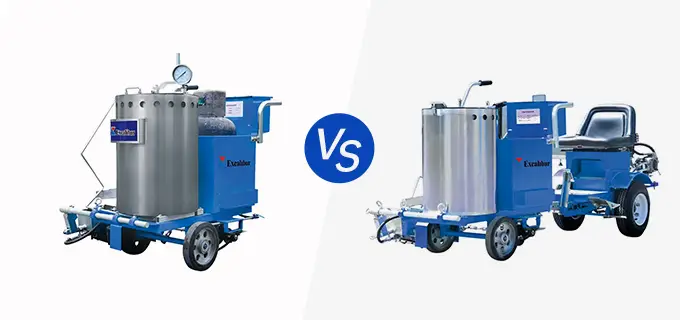Whether you are building a warehouse floor, a driveway, a patio, or a large industrial slab, the quality of the screeding process determines how durable, flat, and long-lasting the concrete will be. Achieving the right compaction, surface smoothness, and levelness directly impacts structural strength, finish quality, and long-term maintenance requirements.
In today’s construction industry, contractors and builders typically choose between two main tools for leveling fresh concrete: manual screeds and vibrating screeds. While both serve the same purpose—removing excess concrete and creating a uniform surface—they operate differently and perform best under different conditions.
So, which option better suits your project? This article compares vibrating screeds vs. manual screeds in terms of performance, labor needs, cost, finish quality, and ideal applications, helping you make the right choice.
What Is a Manual Screed?
A manual screed is the most traditional and basic tool used for concrete leveling. It typically consists of an aluminum or wooden straightedge that workers pull across the surface of wet concrete to remove excess material and create a level grade.
How It Works
Two workers hold each end of the tool and drag it across the concrete slab, usually along pre-installed forms. The motion “cuts off” extra concrete while helping distribute aggregates.
Where Manual Screeds Are Used
Manual screeds are commonly used in:
- Small patios or sidewalks
- Garden pathways
- Driveway patches
- Small indoor slabs
- Projects with limited working space
Manual screeds are simple, lightweight, and require no power source, but they rely heavily on operator skill and physical effort.
What Is a Vibrating Screed?
A vibrating screed is a motorized tool that not only levels the concrete but also uses vibrations to settle aggregates and compact the surface simultaneously. This results in a flatter, denser, and more uniform slab.
Main Components
- Engine or electric motor
- Vibrating blade (aluminum or magnesium)
- Adjustable handle for operation
How It Works
When the motor is powered on, the blade vibrates at high frequency. As the operator pulls the screed across the surface, the vibration pushes excess concrete backward, compacts the mix, reduces air pockets, and brings excess water to the surface.
Typical Applications
- Warehouse floors
- Residential house slabs
- Parking lots
- Roads and walkways
- Industrial flooring
- Medium- and large-sized construction projects
Because it improves efficiency and finish quality, vibrating screeds are widely used in both residential and commercial construction.

Detailed Comparison: Vibrating Screeds vs. Manual Screeds
To understand their differences, it helps to evaluate both options across key performance categories.
Basic Comparison Overview
| Feature / Category | Manual Screed | Vibrating Screed |
| Speed | Slow | Fast |
| Labor Requirement | 2–3 workers | 1–2 workers |
| Compaction | None | Built-in vibration for better compaction |
| Finish Quality | Depends on skill | Smooth, consistent, professional |
| Cost | Low | Higher initial investment |
| Project Size Suitability | Small | Medium to large |
| Ease of Use | Simple but tiring | Requires training but reduces fatigue |
| Portability | Very easy | Moderate (heavier motor unit) |
Efficiency and Speed
Manual and vibrating screeds differ most significantly in their working speed.
Manual Screed Efficiency
Manual screeds rely on physical motion, making them slower and more labor-intensive. Two workers must pull the tool simultaneously while keeping pressure even. This coordination requires effort and slows down the placement process.
Manual screeds are often adequate for small slabs but become impractical for larger areas. Fatigue tends to lead to uneven passes, forcing rework or touch-ups.
Vibrating Screed Efficiency
A vibrating screed dramatically increases leveling speed. The motor drives the blade forward as vibrations level concrete faster with fewer passes.
In most cases, a vibrating screed can complete a job 30–50% faster than manual methods. This makes it ideal for contractors working under tight deadlines.
Compaction and Structural Quality
Compaction plays a vital role in concrete performance. Without proper settling of aggregates, weak points or voids can form.
Manual Screed Compaction
A manual screed provides almost no compaction. Workers must rely on additional tools like rakes, tampers, or bull floats to flatten the slab. This takes time and increases labor demand.
In larger projects, lack of compaction can lead to:
- Decreased surface strength
- Air pockets
- Surface undulations
- Reduced slab durability
Vibrating Screed Compaction
A vibrating screed combines leveling + compaction in a single pass. The vibrating blade forces aggregates downward, reduces air voids, and improves concrete density. This results in:
- Stronger slabs
- More durable surfaces
- Reduced risk of cracking
- Improved long-term performance
This built-in compaction offers a clear advantage manual screeds can’t match.
Labor Requirements and Worker Fatigue
Manual Screed Labor Requirements
Manual screeding is physically demanding. Workers must:
- Lift the screed
- Maintain even pressure
- Pull it without jerking
- Repeat multiple passes
This can be tiring, especially over large pours. More workers are typically needed, increasing labor cost.
Vibrating Screed Labor Requirements
A vibrating screed reduces the workload significantly. The machine provides most of the force, meaning:
- Fewer workers are needed
- Less physical effort is required
- Workers can maintain productivity longer
For contractors, reduced labor translates into better cost efficiency.
Finish Quality and Flatness
Concrete finish quality is essential for any professional job.
Manual Screed Finish
Manual screeds can produce acceptable results on small-scale projects, but outcome depends heavily on:
- Worker skill
- Physical strength
- Consistent pulling motion
Any uneven pressure can produce waves or dips in the concrete.
Vibrating Screed Finish
Vibrating screeds deliver a more uniform, flatter surface. The vibrations help settle aggregates evenly and eliminate high and low spots. This ensures:
- Professional-grade smoothness
- Reduced need for rework
- Easier finishing with bull floats and trowels
Flat, uniform concrete surfaces are critical in warehouses and commercial showrooms.
Cost Considerations
Both tools differ in price and long-term value.
Cost & ROI Comparison
| Cost Category | Manual Screed | Vibrating Screed |
| Initial Cost | Very low (basic tool) | Medium to high |
| Operating Cost | None | Fuel or electricity |
| Labor Cost | Higher (more workers needed) | Lower over time |
| Long-Term ROI | Low | High |
| Maintenance | Minimal | Occasional servicing required |
Which Is More Cost-Effective?
For occasional users or very small jobs, the manual screed is the cheaper solution.
But for contractors, builders, and frequent users, vibrating screeds offer far better ROI by saving time and reducing labor expenses.
Ideal Applications for Each Type of Screed
When to Choose a Manual Screed
A manual screed is best suited for:
- DIY home projects
- Small sidewalks or patios
- Restricted spaces where machines cannot fit
- Rare or occasional concrete work
It is also useful as a backup tool on job sites.
When to Choose a Vibrating Screed
A vibrating screed is ideal for:
- House foundations
- Commercial floors
- Parking lots
- Warehouses
- Large driveways
- Road construction
Any project requiring high-quality finish or faster job completion benefits greatly from vibrating screeds.
Pros and Cons
Advantages of Manual Screeds
- Extremely affordable
- Lightweight and simple
- No fuel or electricity needed
- Easy to transport
Disadvantages of Manual Screeds
- Slow and labor-intensive
- Uneven results on large slabs
- No compaction
- Requires multiple workers
Advantages of Vibrating Screeds
- Fast leveling
- Built-in compaction
- Professional finish
- Reduces worker fatigue
- Efficient for large projects
Disadvantages of Vibrating Screeds
- Higher purchase cost
- Needs training and proper handling
- Heavier than manual screeds
- Requires fuel or electric power
Which Screed Should You Choose?
Choosing between vibrating and manual screeds comes down to your project size, budget, and quality expectations.
Choose a Manual Screed if:
- You only work on small slabs.
- You have a low budget.
- You need a screeding tool for occasional or DIY jobs.
- You must work inside a small, confined space.
Choose a Vibrating Screed if:
- You need speed and efficiency.
- You want a flatter, more professional finish.
- You work on medium or large slabs regularly.
- You want to reduce labor cost and operator fatigue.
- You need both leveling and compaction in one tool.
For most commercial contractors and construction teams, the vibrating screed is the clear winner because of its efficiency, performance, and long-term value.
Both vibrating screeds and manual screeds play important roles in concrete construction. Manual screeds are affordable tools suited for small projects. However, vibrating screeds offer significant advantages in speed, compaction, and finish quality—making them the preferred choice for professionals, contractors, and large construction projects.
If your goal is to achieve higher flatness, reduce labor demand, and finish concrete faster, the vibrating screed is the better investment. For simple jobs or tight budgets, the manual screed is still effective and reliable.



